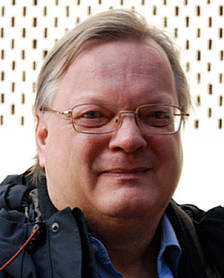Plenary Speakers
Poetry, music, elusive feeling all contribute as the fabric of our imagination, as pure icons, to the occurrence of change, despite the steady pull of permanence, in the self construed as a triadic interpretative process (Colapietro). Cognitive elements and our perception of the world cooperate with the imagination in our endeavor to make sense of the world. To illustrate the relevance of iconicity in the development of human identity, I have chosen the German film The Lives of Others (von Donnersmarck, 2006). Its narrative depicts the dialectical tension between change and permanence in a most unlikely character, an officer of the dreaded Stasi. When the film begins, we see him as the embodiment of the darkest aspects of the ideology of an authoritarian regime, in the second half of the 20th century. The logician Peirce uses an unexpected term to describe the functioning of icons in triadic semiotic, namely, “dreams”. Icons are the manifestations of the simplest phenomenological category, Firstness as the qualitative component of experience. Although they are only possibilities (qualisigns), which are not yet materialized, icons are what enables symbols to generate meaning, such is their “dream exciting power” (CP 4.56) claims Peirce. Far from subordinating images to words, the rationalistic bias that has haunted philosophy since the onset of modernity (Ransdell), triadic semiotic proposes to analyze meaning as the necessary triple coordination of absolute qualities (icons), resistant facts (indexes) and law-like regularities (symbols). I consider this film to be an allegory of what happens when spontaneity construed as the qualitative possibility of change in our lives, of imagining ourselves different from what we are at a certain point in time, is crushed under the oppressive burden of an unchanging Law that forbids and persecutes divergence, since any form of alterity is seen as a threat to an all powerful State. Change in the protagonist takes place through the subtle irruption of some qualities in his imagination, such is the opening to iconicity that overthrows the monological and monolithic identity that had taken over the self (Wiley), which is conceived as the endless growth of reasonableness. Human imagination is construed as the freewheeling, spontaneous influence of iconicity in our lives, a liberating path to regain freedom and the capacity to see oneself and others in a new light.
The role of iconicity in language acquisition and evolution
Mutsumi Imai, Keio University at Shonan-Fujisawa
Language is a system of abstract symbols. To address the symbol grounding problem (Harnad,1998), which is directly linked to key problems in language acquisition and evolution, we need to consider not only how children map their physical and sensory experiences to the first set of symbols but also how they de-ground from “here and there” and climb the ladder into an inter-connected system of abstract concepts, which are largely language-specific. In this talk, I propose the sound symbolism bootstrapping hypothesis (Imai & Kita, 2014 ) and discuss evidence for it. I first explore how pre-verbal infants break into the world of symbols with the help of sound symbolism, presenting results of a series of experiments using EEG and NIRS. I then discuss how sound symbolism can develop into language-specific systems, each of which has its own way in mapping meanings to sounds, based on the results of an experiment that elicited production of sound symbolic words in Japanese and English speakers. I finally discuss how children de-ground from direct iconicity and immerse into conventional language, much of which does not contain apparently sensible sound symbolism .
Cinematic Metaphor - An interdisciplinary framework to metaphor in audiovisual media and in face-to-face interaction
Cornelia Müller, Europa-Universität Viadrina
Metaphors in audiovisual media as well as in multimodal interaction receive increasing attention across disciplines. The specific media character of film and the fundamental intercorporeality of face-to-face interaction, go, however, largely unnoticed. Audiovisual images are all too frequently understood as iconic representations and material carriers of information. Here is where Cinematic Metaphor proposes an alternative perspective: starting from film images as affective experience of movement-images, it replaces the cognitive idea of viewers as information-processing machines, and heals the break with rhetoric established by conceptual metaphor theory (Müller & Kappelhoff 2018). Cinematic Metaphor draws on theories of cinema that address this media specificity and extends them to other audiovisual forms such as television news, campaign commercials, or music video. Despite their differences, these forms share a fundamental mode of perceptual experience that Sobchack has characterized as “An expression of experience by experience” (Merleau-Ponty 1968 [1964], 155, in Sobchack 1992, 3). Following Vivian Sobchack’s neo-phenomenological understanding of cinema, Cinematic Metaphor, thus, conceives of the narrative, the film, to be produced by spectators in their embodied experiences of film-viewing. Narratives are not the starting-point, but the product of metaphorical thinking; they are ‘done’ by the spectators. Rather than conceiving of metaphors as instantiations of image schemas or primary metaphors, metaphoricity is considered to be emerging locally from the spectator’s experiencing of movement-images in the moment of film-viewing. ‘Doing’ cinematic metaphor is a co-production of two agents: the viewer and the film and this is one of the important connecting points between film-viewing and face-to-face interaction. Metaphors emerge dynamically from embodied interactions. Metaphorizing in face-to-face interaction shares this fundamental positioning with film-viewing. To sum up, by taking the mediality of audiovisual images as vantage point for theorizing metaphor, film-viewing as a specific mode of experience becomes a starting point of an alternative theory of metaphor in audiovisual media and in face-to-face interaction. Against the backdrop of a dynamic, intersubjective and reflexive understanding of embodied experience, a shared vantage point for metaphorical meaning making in film-viewing and face-to-face interaction is outlined.
The intricate dialectics of iconization and structuration - Primary iconicity, secondary iconicity, and anything in-between
Göran Sonesson, Lund University
About twenty-five years ago, I suggested that, to account for the workings of iconicity, it was necessary to make a distinction between primary iconicity and secondary iconicity. A primary iconic sign (such as a picture) is a sign in which the similarity between the expression and the content is at least one of the reasons for positing a sign relation. A secondary iconic sign, on the contrary, is a sign in which the existence of a sign relation is at least one of the reasons for positing a similarity between expression and content. The latter may happen, I went on to suggest, because you need a convention to see that something is a sign rather than an object in its own right, as for instance at a car exhibition. Or the reason for it may be that what might serve as the expression of the sign as such is too ambiguous to be given a specific interpretation without a “key” being supplied. My considerations were prompted by my study of iconicity of visual vehicles, but the distinction has later been taken up within linguistics, gesture studies, and the semiotics of music. At the same time, it has become clear to me that the distinction is not entirely satisfactory. To begin with, it obviously has to be understood, as the distinction between between iconicity, indexicality, and symbolicity, in such a way that none of these labels exclude each other. But, more importantly, it would seem to involve a difference of cognitive operations rather than inert structures.




Professor of Theory & Methodology, Facultad de Información & Comunicación, Univ. de la República. He has taught in Uruguay, USA, Norway, Germany, Brazil, Chile, and Canada. He has published ten books and over a hundred scholarly articles and chapters mostly on the representation of the real in audiovisual media, based on Peirce’s triadic semiotic. Some of his recent publications: Una travesía metafórica hacia el realismo semiótico de C. S. Peirce (2017); Vers une écologie de l’ altérité au Brésil et au Canada: une analyse sémiotique comparative des représentations indicielles dans le film documentaire (2015); Uma abordagem semiótica e indicial da identidade na era de YouTube (2015); Semiotic Gold at the End of Peirce s Rainbow: on the Fallible Pursuit of Reality (2014);The lure of the powerful, freewheeling icon: On Ransdell’s analysis of iconicity (2013).
Mutsumi Imai, Keio University at Shonan-Fujisawa
Professor of Psychology at the Faculty of Environment and Information Studies at Keio University. Her goal is to understand how children build up their lexicons and how universal and language factors affect lexical development. Imai’s research interests include four topics that are deeply interwoven with one another: (1) How children learn language; (2) The role of language in conceptual development; (3) The relation between language and thought (in cross-linguistic contexts) in children and adults; (4) The relation between speech sound and meaning (sound symbolism) in language, and how sound symbolism scaffolds language development.
Cornelia Müller, Europa-Universität Viadrina
Professor of Language Use and Multimodal Communication at European University Viadrina, Frankfurt/Oder (Germany). She has published on multimodal forms of language use, focusing on gesture as an expressive medium (motivation and conventionalization), on embodied processes of multimodal communication, and on the experiential dynamics of metaphoric meaning in speech, gesture, and audiovisual media. Her books include: Metaphors, Dead and Alive, Sleeping and Waking: A Dynamic View (2008, UoC Press) and together with H. Kappelhoff Cinematic Metaphor. Experience – Affectivity – Temporality (2018).
Professor of Semiotics at Lund university and was the head of Centre for cognitive semiotics at that same university. He has a doctorate in linguistics from Lund University and another one in semiotics from École des Hautes Études en Sciences Sociales. He has written extensively on visual semiotics, epistemology of semiotics, semiotics of culture, and, more recently, cognitive semiotics and cultural evolution. His publications include Pictorial concepts (1989), a well as numerous articles in well-known journals such as Semiotica, Sign System Studies, Actes sémiotiques, Degrés, VISIO, Signa, Signata, deSignis, etc., in many anthologies and conference proceedings. His most well-known work, initiated in Pictorial concepts, but pursued all along his carrier, concerns the critique of the critique of iconicity, and the development of the iconicity concept to include different varieties.
